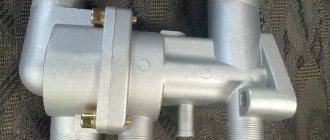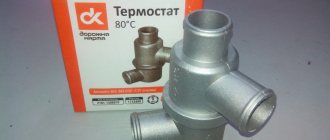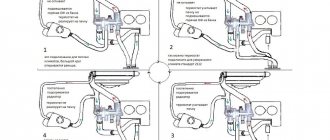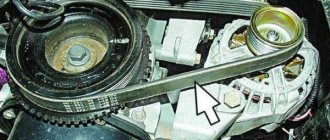If the car engine overheats or the antifreeze temperature does not reach operating temperature, the thermostat may be a possible cause of these malfunctions. There is no difference when replacing the thermostat on Lada cars (Granta, Kalina, Priora, Vesta, Largus, Niva or XRAY) with 8 and 16 valve engines, all actions are performed in the same way.
You will need : drain the coolant, prepare a flathead screwdriver, a Phillips screwdriver, a set of wrenches and silicone sealant.
Procedure:
- Remove the engine air filter housing by disconnecting the hose and the connector with the MAF wires.
- Loosen all thermostat hose clamps (their number may vary depending on the thermostat model).
- Remove the thermostat assembly by unscrewing the two screws securing it and removing the ground connector and the connector with wires from the temperature sensor.
The thermostat is installed in the reverse order, after first cleaning the seat from dirt and applying sealant. The whole process is also shown in the video:
Let us remind you that it is better to check it before installing the thermostat. If this is not the problem, check the cooling system according to the diagram.
As you know, modern cars use a special liquid to cool the power plant. The versatility of this option allows you to simultaneously provide interior heating in winter.
In order for this system to work properly, a special device called a thermostat is also installed in it. In another way, it is also called a coolant temperature regulator. One of its functions is to help the engine warm up as quickly as possible and maintain it in the required condition.
In this article we will talk about how the thermostat of a Grant car is converted to a higher response threshold (92 degrees). In addition, we will tell you about the principle of operation of this device and about possible problems that arise in it.
How does it work
Specifically in Grant, the thermostat is located between the power plant and the radiator. The main task of the unit in question is to prevent the circulation of antifreeze until the engine warms up to the required temperature. If the engine remains cold, the coolant does not move.
Ideally, the thermostat operates after the temperature of the power plant reaches 80-95 degrees. All this allows, among other things, to reduce the volume of emissions harmful to the environment and minimize engine wear.
By the way, checking the functionality of the thermostat is relatively easy. It must be placed in a container with boiling water. If the element is working properly, its valve will open approximately 20 millimeters.
Short scheme of actions
A simple way to check the thermostat without removing it from the car is to monitor the temperature of the radiator pipe whose inlet or outlet is blocked by the mechanism. Whether it is an upper or a lower hose will become clear after studying the design of the cooling system of a particular car. As the engine warms up, it should be cold, and when the engine reaches operating temperature, it should heat up sharply. If the tube heats up immediately or is cold even when the power plant is warm, the thermostat is faulty.
When purchasing a new thermal switch, blow into the connector directly from the seller. A complete test for suitability for installation is carried out in a pan. The part is lowered into cold water, the liquid is heated and the fact of the opening of the large and closing of the small circle at a certain temperature is established.
Sometimes the car's cooling system fails. The engine temperature arrow on the dashboard goes off scale after a few minutes of warming up. And sometimes the opposite happens - the temperature, especially while driving, does not reach the operating value of 90 degrees.
These are all sure signs that it's time to check the important device that controls coolant flow. Many people know that this completely closed assembly consists of a valve and a heat-sensitive substance. The latter, when heated, opens a large circuit - the radiator - through the coolant valve.
But how to check the thermostat, because that’s what we’re talking about, on your car? And most of all, car enthusiasts are interested in how to check the thermostat without removing it from the car? Let's try to give some advice on this matter.
Without dismantling the device, this is the only way to correctly diagnose it.
- Start the engine, then wait two minutes.
- Touch the hose directed from the device being tested to the radiator.
- If the hose is hot, the device is faulty; most likely, the valve never closes.
- If the hose remains cold even after 5 - 10 minutes of warming up, and the temperature on the panel is already more than 90 degrees, the unit is also faulty. Most likely, the valve, on the contrary, does not open.
Common faults
Despite the relative simplicity of the device, troubles sometimes occur with it. A malfunctioning thermostat will most likely render the vehicle unable to be driven. More often, its incorrect operation is provoked by the following reasons:
- unstable functioning of the motor (when tripling, the valve is often damaged);
- antifreeze getting inside the device;
- wax flows out;
- mechanical damage to the valve;
- deterioration of the rubber gasket;
However, there is usually one main reason - corrosion.
If for some reason the valve does not open at all, the coolant does not circulate and the power plant overheats. Moreover, the problem will arise regardless of how cold it is outside and how quickly the car accelerates.
Incomplete opening of the valve also causes overheating. True, in this case it will not be critical if external factors do not contribute to this. A delay in closing leads to a prolonged warm-up of the engine, and in winter it most likely will not be able to reach operating temperature.
Basic thermostat malfunctions
The thermostat is a small, but no less important component of the car. A malfunctioning thermostat will most likely strand you on the side of the road. There are many reasons why a thermostat fails, but the most popular reason is corrosion.
If the thermostat is stuck and is in the completely closed position, the engine will most likely overheat, regardless of the driving mode and ambient air temperature.
If the thermostat is in the open position, but not all the way, the motor will overheat, but there is a possibility that it will not “boil”. Whether this happens or not depends on how the car is used.
If the thermostat valve is held in a completely or partially open position, it will take a very long time for the engine to warm up to the required operating temperature; in winter, the engine may not reach such a temperature.
With a working cooling system at a temperature of zero degrees, the engine warm-up time should take up to 10 minutes. In case of defective opening, the engine temperature will not rise above 70 degrees even in summer.
In both of these cases, it is necessary to replace the thermostat on the Grant or any other car. Next, let's look at how to check whether our thermostat is functioning.
Revision option
As evidenced by reviews from grant owners, the manufacturer supplies this model with a rather weak thermostat. Usually it opens access to antifreeze after the engine warms up to 80 radii. This is due to low-quality wax inserts, which we described above.
In most cases, such a problem is not perceived as something serious, since it does not harm the operation of the engine in any way. The only drawback is that in winter, when there is frost, the interior can be cool. The situation becomes more complicated if the owner of the car switches to gas.
In this case, it makes sense to modify the thermostat so that it opens at 92 degrees. To do this you will need to purchase a new one. The entire element does not need to be replaced, so only the insert is taken out of the purchased one.
Experts advise choosing the model – VERNET TH4898.92D. Its cost is low - approximately 400 rubles.
The step-by-step replacement procedure is as follows:
- first of all, the car is driven onto a ramp or pit;
- drain antifreeze from the cooling system;
- remove the air duct because it is in the way;
- the thermostat itself is dismantled (but you can leave it in place and only remove the cover from it, the main thing is not to lose the seal);
- the old thermocouple is removed and a new one is inserted;
- they press it with the original spring and limiter.
On average, the response temperature after such a procedure increases by 15 percent.
The whole process is recorded in this video:
All cars whose engines are cooled by a special liquid have at their disposal a device called a thermostat. Lada Granta is no exception.
In the Grant model, the thermostat is located between the radiator and the engine. In the article we will talk about the concept of a car thermostat, what components it consists of and how it functions, and also consider the main types of thermostat malfunctions.
The thermostat is called the antifreeze (antifreeze) temperature regulator in the engine cooling system. It increases the engine warm-up rate and maintains the required thermal state.
The key job of the thermostat is to hold back the flow of radiator fluid until the engine has warmed up. If the engine remains cold, the coolant does not pass through it to the radiator.
The thermostat opens when the engine temperature reaches 95 degrees. Thanks to its operation, the engine warms up faster. Thus, in the Lada Granta, the thermostat reduces the amount of harmful emissions and reduces engine wear to a minimum.
If desired, you can clearly see the operation of the thermostat at home. Place the thermostat in a container filled with water, then place it on the electric stove. As the moment of boiling water approaches, the thermostat valve will open approximately 2 cm. It is recommended to experiment with a new thermostat without removing yours from your own car.
Owner reviews
| № | Positive |
| 1. | Gennady: 65,000 km, no comments on the cooling system elements. For my part, I try to systematically carry out technical inspections and fill in high-quality antifreeze. |
| 2. | Vladimir: at 75,000 km I replaced the “regulator” for the first time, I think that for a domestic car the service life is more than good. |
| 3. | Alexander: During the two years of operation of the machine, breakdowns occurred, but there were no large-scale ones. I eliminated the unimportant ones on my own. Of course, “our” manufacturer is far from perfect, but the quality is an order of magnitude higher than previous modifications. |
| 4. | Sergey: The stove heater in Grant heats very well, it’s hot, I often open the windows for ventilation. I don't remember early models having this quality. |
| 5. | Vasily: I’m pleased with the build quality of the domestic car; there are some faults, but they can be easily fixed on your own. |
| 6. | Gennady: after buying the car, I immediately drained the “native” antifreeze and filled it with high-quality imported one. The cooling system works like a clock. |
| 7. | Dmitry: I’m happy with the car, the units are working as normal. I follow the maintenance schedule and buy original parts. |
| Negative | |
| 1. | Kirill: I drove 35,000 km without any breakdowns, and then the car started to fall apart. In a year and a half, I have already visited a service station twice unscheduled for diagnostics. |
| 2. | Stepan: I regretted that I bought Grant, the model is crude, there are many flaws and defects. The manufacturer is in no hurry to fix it. |
| 3. | Victor: don’t rush to buy Grant; Renault Logan can be used as a good alternative. |
Properly assembled thermocouple
Conclusion
As standard, the Lada Granta is equipped with parts from a domestic manufacturer. The average service life of heating system elements is 75 – 80 thousand km.
As an alternative to domestic elements (21082), owners purchase foreign analogues, such as Wahler, Stellox. The service life is 10–15% longer, but the price is an order of magnitude higher. It's worth thinking a few times before buying.
| Video - Replacing the grant thermoelement |
| Video - Lada Granta thermostat thermocouple or why the car takes a long time to heat up and cools down quickly |
| < |
Thermostat structure and operating conditions
The thermostat contains metals such as copper and brass alloy. The essence of the device's operation lies in a small cylinder turned towards the engine.
In the middle of the cylinder there is a synthetic wax ball, which at a certain temperature (82 degrees Celsius) begins to melt (the wax expands significantly under the influence of heat, changing its solid state to a liquid).
A special pin is pressed into the wax cylinder and is connected to a valve. When the wax melts, as a result of expansion, it begins to squeeze the pin out of the cylinder, while opening the valve through which coolant flows. When the engine stops and cools, the wax in the thermostat hardens and returns to its solid state.
Solid thermostat
Currently, as a rule, thermostats with solid filler are used. They have two valves and by design cannot be disassembled. Such a device includes: thermostat housing; nozzles (2 pcs. - for inlet, 1 pc. - for outlet); valves (2 pcs. – main and auxiliary); sensitive element.
The thermostat is located in the coolant supply path to the centrifugal pump. The thermostat is connected to the pump using the outlet pipe. At the same time, the thermostat is connected using one pipe to the cylinder head. The second inlet pipe is used to connect to the radiator tank located below.
The sensitive element consists of a copper cylinder, a rod, and a diaphragm made of rubber. The solid filler is contained between the wall of the copper cylinder and the diaphragm. The filler has the ability to expand significantly. It consists of a special wax made of small crystals, or a special compound (ceresin + copper powder).
When the coolant temperature reaches above 80 °C, the filler begins to melt, expanding its volume - after which it pushes the rod, which, in turn, presses on the cylinder. The cylinder moves upward, closing the auxiliary valve in the thermostat. Thus, antifreeze no longer circulates in a small circle.
Thanks for subscribing!
When the coolant temperature exceeds 94 °C, the auxiliary valve closes completely. In this case, the main valve is open, the coolant is freely distributed throughout the larger circulation circle, which includes the radiator.
When the coolant temperature drops to 80 °C and below, the main valve in the thermostat gradually closes due to a reduction in the volume of solid filler - as a result, the radiator coolant flow disappears, but the auxiliary valve opens, which allows the coolant to flow freely through a smaller circulation circle.
In other words, the thermostat controls and maintains the proper temperature in the engine at the same level - as a result, engine components and assemblies will function longer.
MAHLE Thermostats — How do they work? | Perfect Performance & Long Life for Combustion Engine
How to tell if the thermostat is working correctly
In order to find out whether the thermostat is working or not, it is necessary to warm up the engine so that the arrow indicating the temperature does not reach the red mark of the indicator quite a bit.
After that, turn off the engine, go to the hood and open it, look for the upper radiator hose. This rubber hose is usually black in color and is approximately 5cm in diameter.
There are metal clamps at its ends. The upper hose is attached to the top of the radiator. Then we look for the lower hose. It looks like the top one, only it is attached to the bottom of the radiator.
Touch the hoses carefully; they may be hot enough to burn you. If the engine temperature indicator shows that the engine is hot, but one of the hoses is cold, then most likely the thermostat valve is closed and is not allowing coolant through the radiator.
In this case, replace the old thermostat with a new one as quickly as possible (after waiting until the engine has cooled down).
There is another “folk” method for checking the functionality of the thermostat and it is as follows. Place the thermostat in a vessel with boiled (temperature should be about 100 degrees) water.
Next, we visually observe whether the thermostat valve opens. If it opens, it means it’s working. If not, we replace the damaged one with a new one. The above method involves removing the thermostat from the car.
If the thermostat malfunctions in a car, overheating or, more often, low engine temperature is observed. Such phenomena are associated with the thermostat jamming in one position; as a result, the coolant moves in one circle (large or small). Lack of adjustment of coolant distribution leads to deviations from the engine temperature regime. Thermostat failure is one of the most common problems in a cooling system. To replace the thermostat on a Lada Granta car, the coolant from the cooling system does not need to be completely drained.
You will need: TORX TZO wrench, 13mm socket, Phillips-blade screwdriver.
Advantages of LUZAR thermostats
Computer dosage of thermal wax LUZAR thermostats have thermal sensors filled using special equipment, which guarantees high accuracy of operation.
Patented thermal sensor design To eliminate the possibility of a “breakthrough” of thermal wax from the thermal sensor body (which, according to statistics, is the most common cause of thermostat failure), LUZAR changed the configuration of the sealing gasket in the rod-thermal wax-cylinder interface. With increasing pressure, expanding when heated, the thermowax gasket design - thanks to its specific geometry - forms an increased volume of rubber precisely in places where the thermowax “breakthrough” may occur
This also required changing the geometry of the temperature sensor housing (“cylinder”).
Rubberized valves We have eliminated the cause of insufficient tightness of the thermoelement - the metal-to-metal interface between the metal frame of the thermoelement and the metal valve plate - by using a rubber sealing gasket on the valve plate. Thus, LUZAR thermostats provide faster engine warm-up in winter (which is so important in Russian conditions climate).
100% control of thermoelements Each thermoelement is tested for temperature, height and response speed - carried out in special baths with cells.
Warranty 2 years or 125,000 km. Mandatory certification In the event of a breakdown, you can easily replace the purchased thermostat through a retail store - just return it with a warranty card and a description of the defect
All products are certified according to the international quality management system ISO 9001 TUV and have GOST-R certificates of conformity.
Removing the thermostat Lada Granta
The thermostats of the 8-valve engines and the 16-valve Lada Granta engine are located differently, and therefore their replacement for these engines is shown separately. To remove the thermostat of the VAZ-11183, VAZ-21116 and VAZ-11186 engines, do the following: 1. Remove the plug from the expansion tank. Unscrew the drain plug at the bottom of the right radiator tank. Drain the coolant that comes out of the engine radiator into a container. Screw the drain plug back in.2. Release the clamp on the coolant temperature sensor wiring harness. 3. ...and disconnect the block from the sensor
4. Loosen the clamp securing the rear hose to the thermostat cover...
5. ...and remove the hose from the cover fitting
6. Similarly, disconnect the front hose from the thermostat housing pipe.
7. Unscrew the nut securing the ground wire to the upper stud securing the thermostat housing...
8. ...and remove the nut, washer and wire end from the stud.










